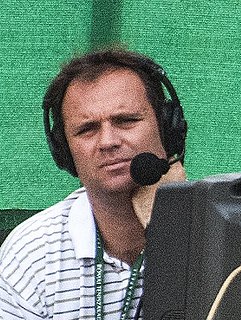
Kiskunhalas is a city in the county of Bács-Kiskun, Hungary.
Count László Markovits de Spizza et Kisterpest is a former tennis player from Hungary, son of water polo player and national team captain Kálmán Markovits and World champion handballer Márta Balogh. He was the winner of Hungarian National Tennis Championships in singles in 1986 and has won it two times. He represented his native country as a lucky loser at the 1992 Barcelona Olympics in Barcelona in singles and partnered with Sándor Noszály for the doubles, but both ended in the first round, losing in four sets and being forced to retire respectively. He reached the second round in the 1988 Seoul Olympics and 1996 Atlanta Olympics teamed up with Gábor Köves. In the 1991 Davis Cup Euro/African Group I 1st Round Play-offs he defended Hungary to be relegated to Group II by winning the second and third match against Morocco resulting in the irreversible 3–0 lead. He was a member as a reserve of the 1993 team, whose victory over Argentina resulted in advancing to the World Group and an active member of the 1995 team who shocked Australia by knocking them out in the World Group play-offs. He was a recurring member of the team over a decade (1987–97) clinching a 9–8 win-loss record in doubles but being less successful in singles. He has later become the chairman of Vasas SC.

Illovszky Rudolf Stadion is a multi-use stadium in Angyalföld, Budapest, Hungary. It is used mostly for football matches and is the home stadium of Vasas SC. The stadium holds 5,054 people.
John Halas was a pioneering Hungarian animator. Together with Gyula Macskássy, and Félix Kassowitz, Halász co-founded Hungary's first animation studio, Coloriton, in 1932. Coloriton existed for 4 years, producing high-quality promotion-oriented animations for television and cinema including Boldog király kincse. Halász learned his craft under George Pal, but launched his own career in 1934, and two years later moved to England where later, with his wife Joy Batchelor, founded Halas and Batchelor in 1940.

Halas and Batchelor was a British animation company founded by husband and wife John Halas and Joy Batchelor. Halas was a Hungarian émigré to the United Kingdom. The company had studios in London and Cainscross, in the Stroud District of Gloucestershire.
Markovits is a Magyarised South-Slavic surname. It may refer to the following people:

Gábor Köves is a retired Hungarian Olympian tennis player. Seoul gold medalists Ken Flach and Robert Seguso stopped him and partner László Markovits in the second round in the 1988 Summer Olympics.
The Hungary Davis Cup team represents Hungary in Davis Cup tennis competition and are governed by the Hungarian Tennis Association.

Andrei S. Markovits is an Arthur F. Thurnau Professor and the Karl W. Deutsch Collegiate Professor of Comparative Politics and German Studies at the University of Michigan. He is the author and editor of many books, scholarly articles, conference papers, book reviews and newspaper contributions in English and many foreign languages on topics as varied as German and Austrian politics, anti-Semitism, anti-Americanism, social democracy, social movements, the European right and the European left. Markovits has also worked extensively on comparative sports culture in Europe and North America.

Dekani is a settlement in the City Municipality of Koper in the Littoral region of Slovenia.

Assumption of Mary Parish Church in Dekani is the parish church of the Parish of Dekani, a village near the city of Koper in southwest Slovenia. It was built in 1229, rebuilt towards the end of the 15th century, consecrated in 1493, and restored and enlarged in 1902.

Katalin Szőke was a Hungarian swimmer. She competed at the 1952 Olympics and won two gold medals, in the 100 m and 4 × 100 m freestyle events. Two years later she repeated that success at the 1954 European Championships. She also competed in these two events at the 1956 Olympics but without success. During her career Szőke set four world records. In 1985 she was inducted into the International Swimming Hall of Fame.

Nogometni klub Dekani, commonly referred to as NK Dekani or simply Dekani, is a Slovenian football club from Dekani, which plays in the Slovenian Second League under the name Jadran Dekani. The club was founded in 1938.
Kálmán Markovits was a Hungarian water polo player who competed in the 1952 Summer Olympics, 1956 Summer Olympics, and 1960 Summer Olympics.

Rodion Markovits was an Austro-Hungarian-born writer, journalist and lawyer, one of the early modernist contributors to Magyar literary culture in Transylvania and Banat regions. He achieved international fame with the extended reportage Szibériai garnizon, which chronicles his own exotic experiences in World War I and the Russian Civil War. Locally, he is also known for his lifelong contribution to the political and cultural press of Transylvania. A Romanian national after 1920, Markovits divided himself between the Hungarian Romanian and Jewish communities, and was marginally affiliated with both the Ma art group and the Erdélyi Helikon writers.
Márta Balogh was a Hungarian international handball player, multiple Hungarian champion and Hungarian cup winner, and gold medalist of the 1965 World Championship.
Hungária körúti stadion was a stadium in Józsefváros, Budapest, Hungary. The stadium opened in 1912 and served as the home for the MTK Budapest FC until 1945. The stadium was demolished during World War II, and a new stadium built in its place from 1946 to 1947.

"¡Hala Madrid! ...y nada más" is an anthem for the Spanish football club Real Madrid. It was written by RedOne and Manuel Jabois and released in celebration of Real Madrid's 10th win of the UEFA Champions League in 2014. It was recorded by Real Madrid squad for the 2014 final. It reached number one in the Spanish chart after the win. It is now an anthem regularly played at the Santiago Bernabéu Stadium with fans chanting the chorus.












